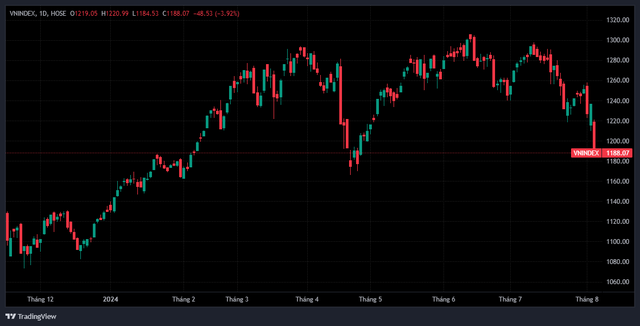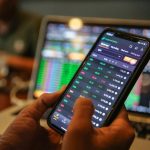Expectations of investors that the leading stock index of Vietnam would surpass the 1,300-point mark were dashed on August 5th as a selling frenzy quickly took hold, spreading across all stock groups. The focus was on the large-cap VN30 stocks, which plummeted simultaneously, with all 30 stocks declining.
At the close, the VN-Index broke below the 1,200-point threshold, settling at 1,188.07, a decrease of 48.53 points (-3.92%). This was the second time this year that the VN-Index lost more than 40 points in a single session. While liquidity saw some improvement, it wasn’t dramatic, with matching value reaching approximately VND 21,260 billion on the HoSE.
In terms of market breadth, 844 stocks declined, of which 127 hit the daily limit down. Real estate, banking, securities, steel, oil and gas, and fertilizer stocks were all painted in red, with relatively large declines. The sharp decline also wiped out more than VND 198,000 billion (~ $8 billion) in HoSE’s market capitalization. As of August 5, HoSE’s market capitalization stood at VND 4,860,000 billion.

The unusual movements of the index during the first trading session of the week left many investors bewildered and searching for explanations. Commenting on the market situation, Mr. Nguyen The Minh, Director of Yuanta Vietnam Securities Analysis, stated that on August 5, the Japanese yen recorded a significant rebound, and the recent upward trend has triggered a wave of capital outflows from the Japanese stock market.
Notably, the sell-off was led by technology stocks. Since the beginning of 2024, this group has been the driving force behind the rise of many indexes, such as the Nasdaq in the US and the markets in Japan, South Korea, and others. These are markets where technology stocks have a high weight in terms of capitalization, which is why their decline was so pronounced. The negative sentiment in the Japanese and global markets caused a “Domino effect” among Vietnamese investors, leading to panic selling. The Vietnamese stock market was caught in the crossfire of this wave.
“In fact, investors are quite panicked and are selling off their assets globally, despite positive macroeconomic conditions and stable business fundamentals. The loss of the 1,200-point mark by the VN-Index even triggered a selling frenzy in the Vietnamese market, coupled with margin pressure, causing the market to plunge further,” said Minh.
Minh added that historically, whenever the VN-Index dropped to the 1,200-point level, the market’s P/E ratio tended to fall to around 10 times earnings. History suggests that a P/E of 10 times could indicate a market bottom.
Furthermore, the fundamental stories of businesses are much more appealing now. While downward pressure remains, the current risks are far outweighed by the potential for market gains. Therefore, the Yuanta expert expects the market to reclaim the 1,200-point level in a few sessions.
Additionally, the current dividend yield of stocks is approximately 9%/year, while savings deposit interest rates are at 5.5-6%/year. Investors are currently apprehensive about the market’s outlook and are influenced by herd behavior, but they are expected to return soon, which should improve liquidity.
“Only when the market is overvalued do investors flee for an extended period and return when the market is sufficiently discounted. In the current context, the market has already undergone a significant correction, and investors who sell their stocks will likely re-enter the market immediately,” said Nguyen The Minh.
Sharing this view, Mr. Bui Van Huy, Branch Director of DSC Securities, stated: “The market may retest the MA200 around 1,200 points but will maintain and recover as it did last weekend. While we can’t expect high enthusiasm, there’s no need for pessimism. The Q2 earnings season has passed, but it will serve as a good reference for predicting the recovery of business profits in the latter part of the year. Therefore, this is a time to think long-term.“
Looking at the domestic context, Huy pointed out that many bright spots in the economy and the dissipation of uncertainties, along with positive macroeconomic data, indicate a solid and robust recovery. Despite short-term psychological and liquidity factors, a robust economic recovery always serves as an important foundation for the market.
Investing in a volatile market: Should beginners consider putting money into high-yield bonds for 10-30% yearly profit?
Short-term stock market trading has proven to be a risky venture for many investors, leading to substantial losses. However, there are a few select open funds that have managed to achieve impressive returns, reaching up to 30%.
















